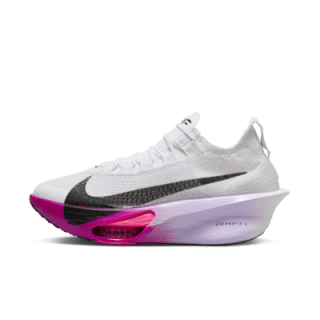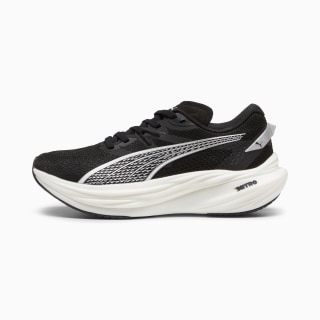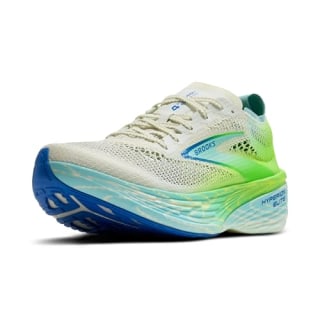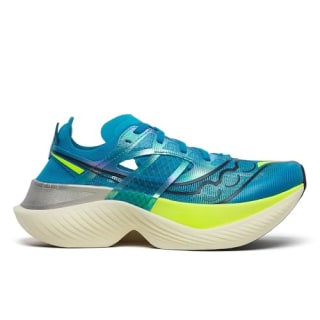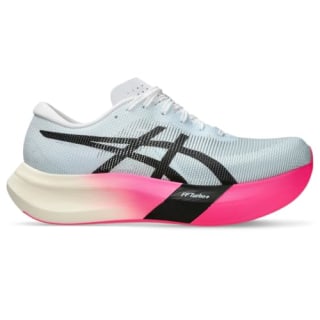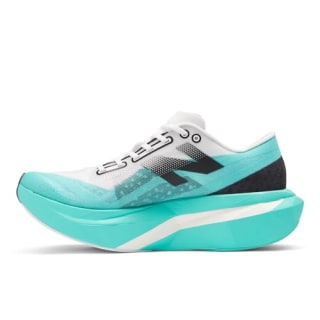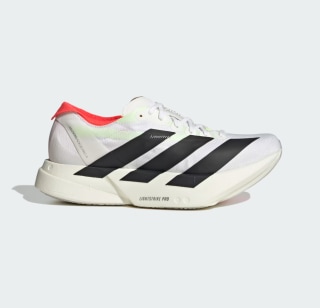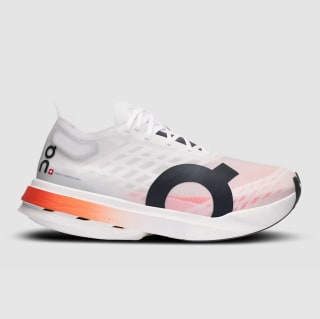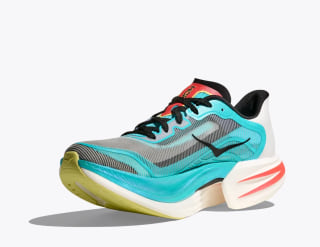If you’ve ever run a race, or seen people training for one, you’ve likely come across them: sneakers with sky-high cushioning that look like they could spring you into outer space. And to some degree, that’s what they’re designed to do. Carbon plated running shoes, also called super shoes, are known for their speedy, lightweight, propulsive feel, making them popular among marathoners and athletes hoping to beat their personal records. But you don’t need to be an elite runner to wear them, says Kenny Krotzer, senior innovation developer at Brooks Running. (Ed’s note: The inclusion of products sold by Brooks in this article was made independently of Krotzer.) They can also help recreational 5K-ers run faster for longer while exerting less effort.
To help you shop for a pair of carbon plated running shoes, I talked to experts about everything you need to know. I also rounded up a handful of highly rated options from brands like Brooks, Nike and Saucony.
SKIP AHEAD What are carbon plate running shoes? | The best carbon plate running shoes of 2025 | Who should (and shouldn’t) wear carbon plate running shoes | How to get used to carbon plate running shoes | Why trust NBC Select?
Want more from NBC Select? Sign up for our newsletter, The Selection, and shop smarter.
What are carbon plate running shoes?
Brands have used carbon fiber as a material in footwear for decades, but what we now think of as “carbon plate running shoes” came to fruition in 2017 when Nike debuted the Zoom Vaporfly 4% shoe, says Krotzer. Experts told me it’s widely regarded as the first modern super shoe.
So what exactly are carbon plate running shoes? They’re specialized sneakers that have a stiff, lightweight carbon fiber plate embedded in their midsole, says Tallent. The plate is sandwiched between thick layers of soft foam, so you usually can’t see it when looking at a sneaker, unless there’s a cutout in the outsole.
Carbon plate running shoes became especially popular in 2019 when Kenyan athlete Eliud Kipchoge, who’s been sponsored by Nike for over 20 years, wore a pair of the brand’s sneakers to accomplish the superhuman feat of running a marathon in under two hours. He was the first person to ever do so. Since then, the carbon plate running shoe market has exploded, and almost every major running brand now makes its own models, says Heini Tallent, a certified running coach and the owner of Elements Running Education.
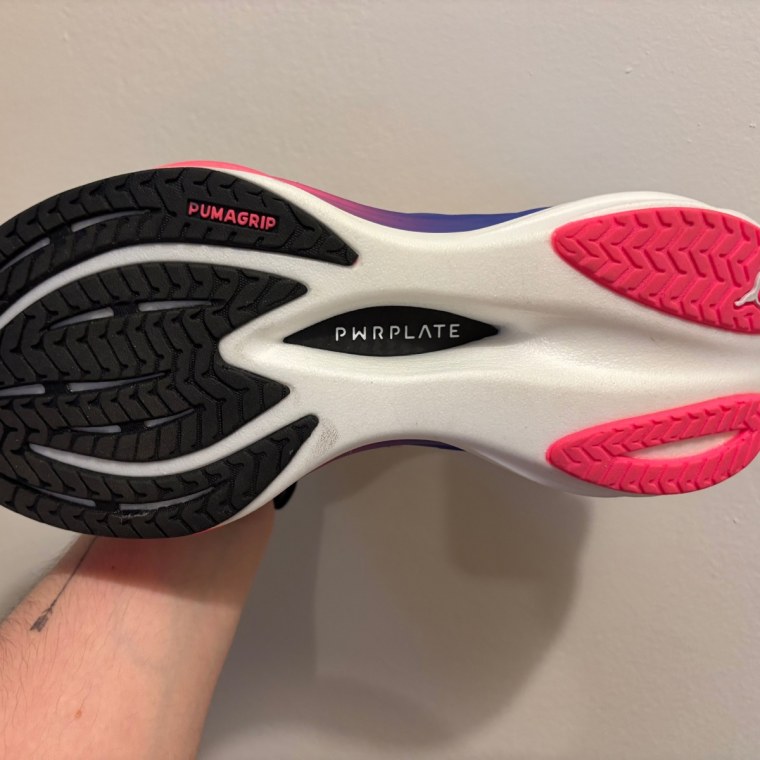
The purpose of a carbon plate is to act as a spring that helps propel you forward while running, says Tallent. It also stabilizes the shoe’s midsole, which increases energy return to make each of your steps more efficient and delay the onset of fatigue, says Caroline Bermel, the head shoe reviewer and a content marketing specialist for Fleet Feet. (Ed’s note: The inclusion of products sold by Fleet Feet in this article was made independently of Bermel.) Anyone can wear carbon plate running shoes, but you usually don’t feel the full impact of the plate until you run above a certain speed. “Elite level athletes and faster marathoners get more of a performance benefit from them than a middle or back of the pack runner,” says Tallent.
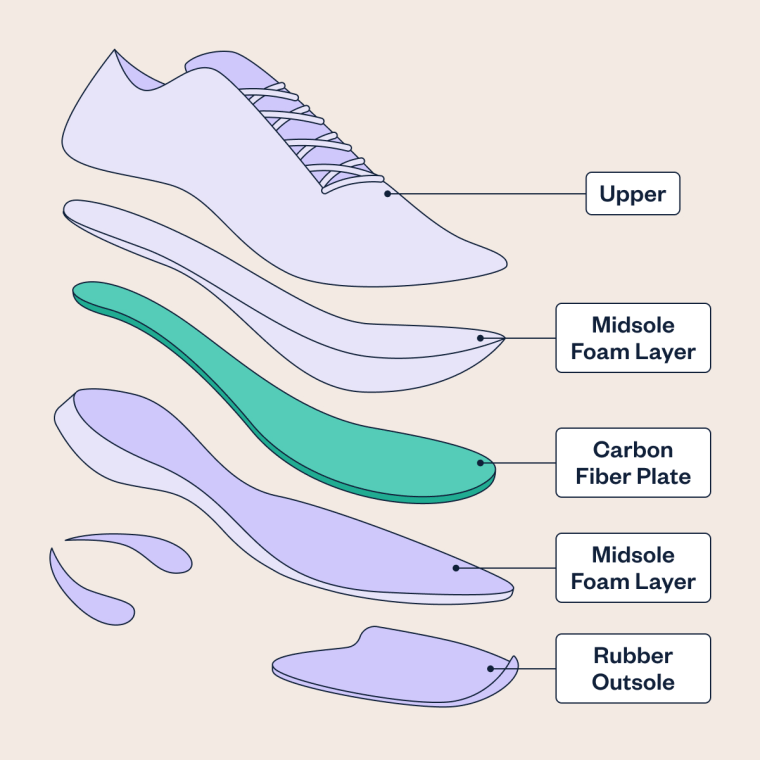
How I picked the best carbon plate running shoes
While shopping for carbon plate running shoes, experts recommend considering the following factors.
- Carbon plate shape and stiffness: Full-length carbon plates extend through the entire midsole of a shoe, making it very stiff, while half and partial plates are shorter, making a shoe less stiff, says Tallent. Carbon plates can also have a segmented or forked structure, which makes a shoe more flexible. Stiff carbon plates usually propel you forward the most, but they can feel harsh to some runners.
- Carbon plate curvature: Brands typically design the curvature of carbon plates to mimic the natural curvature of feet, which supports the heel-to-toe rolling motion of a gait cycle, says Bermel. (A gait cycle is the sequence of movements your legs and feet move through when you take a step.) Still, some carbon plates have an extra pronounced curve or are on the flatter side.
- High-performance foam cushioning: The magic of a super shoe comes from the synergy between high performance foam cushioning and carbon fiber plates. When these two elements work together, it gives the shoes their potential advantage. “The foam is the engine that powers a super shoe, whereas the carbon plate is the steering wheel,” says Krotzer. In conjunction with the plate, high-performance foams give super shoes the bouncy sensation runners have come to expect, says Bermel. These foams are more lightweight and flexible compared to standard foams, and offer more energy return. High-performance foams tend to be unstable on their own, but carbon plates stabilize them.
- Tall stack height: Stack height is the amount of material, measured in millimeters, between the ground and your foot — the taller the stack height, the more cushioning a shoe has underfoot. Carbon plate running shoes typically have a very tall stack height (usually somewhere between 35 and 40 mm.) since they’re super cushioned.
- Rocker-shaped outsole: To help runners quickly and efficiently roll through heel-to-toe transitions, carbon plate running shoes often have prominent rocker-shaped outsoles, says Tallent. Runners who are midfoot or forefoot strikers tend to benefit from this more than heel strikers.
- Type: There’s two types of carbon plate running shoes: racing and training. Racing shoes are designed to be as lightweight as possible to shave seconds off your finish time. They have streamlined uppers often made from perforated materials, and minimal rubber on their outsoles, says Bermel. They’re not the most durable sneaker, so it’s best to use carbon plate racing shoes sparingly — you should run in them a few times to get used to them, but other than that, reserve them for race day. Training shoes, on the other hand, are slightly heavier, more durable and more comfortable. Bermel says they’re a good option for interval, tempo and key long runs while preparing for a race.
- Price: Due to their advanced technology, carbon plate running shoes are pricier than standard sneakers. They typically cost between $200 and $300.
- Return policy: Even if you get professionally fit and try on super shoes in-person, you won’t be able to tell how your feet feel in them until you go for a run. Note a retailer’s return policy in case you need to send them back or exchange them for a different size.
The best carbon plate running shoes of 2025
To recommend the best super shoes, I rounded up highly rated models that meet expert guidance and are from some of the biggest running brands I’ve previously covered. Each pair is available in men’s and women’s sizes, including half sizes.
I included important information about each shoe, like its carbon plate design, weight and heel drop, which is the height difference between a shoe’s heel and toe, measured in millimeters. Every shoe below is on the World Athletics’ List of Approved Athletic Shoes (more on what this means in the FAQ section).
Best overall for racing: Nike Alphafly 3
When Eliud Kipchoge became the first person to run a marathon in under two hours, he wore a version of these sneakers specifically designed for the race. Now, anyone can buy the Alphafly 3, which is the most lightweight shoe on this list. They’re best for half marathons and marathons at a fast pace, according to the brand.
The Alphafly’s ZoomX foam midsole is fully connected to the outsole, making for smooth heel-to-toe transitions. There’s also two Air Zoom cushioning units in the forefoot — they use pressurized air and tightly stretched fibers to absorb impact when you land, then propel you forward when you take off, according to Nike. The shoe has a wide, full-length carbon plate that helps stabilize you, plus a breathable knit upper. Its laces are notched to prevent them from easily untying, and the knit tongue, which is connected to the upper, is padded to take pressure off the top of your foot.
Carbon plate design: full | Heel drop: 8 mm. | Weight: 6.1 oz. | Type: racing | Sizes: women’s 5 to 12, men’s 3.5 to 10.5
Best overall for training: Puma Deviate Nitro 3
I wear these sneakers, which the brand sent me to test, for my weekly runs that are as long or longer than a 10K (about 6.2 miles). I notice their carbon plate’s propulsion the most when I run below a pace of 10 minutes and 30 seconds per mile. The first time I used the shoes, I was shocked by how little work I felt like I was doing to put one foot in front of another. As soon as my feet hit the ground, the sneakers would spring me forward, making each of my steps quick and efficient. The nitrogen-infused foam cushioning keeps me comfortable for miles, and its bounce is controlled so I’m never unstable. The shoe’s outsole also helps me grip the ground whether I’m running on the treadmill or road. Puma recommends the Deviate Nitro 3 for those with neutral arches.
Puma makes a racing version of this sneaker: the Deviate Nitro Elite 3. Compared to the training model, the racing one has a lower heel drop (8 mm.) and is about two ounces lighter (6.8 oz.).
Carbon plate design: full | Heel drop: 10 mm. | Weight: 8.8 oz. | Type: training | Sizes: women’s 5.5 to 11, men’s 7 to 15
Most customized plate: Brooks Hyperion Elite 4 PB
Brooks custom tailors the carbon plate in the Hyperion Elite 4 PB to each shoe’s size, fine-tuning its stiffness relative to the size of the runner, according to the brand. The sneaker, which is best for road races of any length, has PEBA DNA Gold foam, which is Brooks’ lightestest, softest and most responsive type of cushioning. The upper is perforated to maximize breathability, and it has notched laces.
Carbon plate design: wide full | Heel drop: 8 mm. | Weight: 7.2 oz. | Type: racing | Sizes: women’s 6.5 to 13.5, men’s 5 to 12
Most breathable: Saucony Endorphin Elite
It took Saucony four years to develop its Endorphin Elite shoe, which is made with a slotted carbon plate — it’s a full plate that looks like a fork, with fingers near the forefoot and a solid area near the heel. The sneaker also has the brand’s responsive PwrRun HG cushioning and a breathable knit and mesh upper. There’s also cutouts in the upper and outsole to allow even more air to flow through the shoe. It has a raised round toe that helps you roll through strides.
Carbon plate design: slotted | Heel drop: 8 mm. | Weight: 7.2 oz. | Type: racing | Sizes: women’s 5 to 12, men’s 7 to 15
Best for high arches: Asics Metaspeed Sky Paris
The Metaspeed Sky Paris weighs about .78 ounces less than its predecessor — this may not seem like much, but taking any weight off a shoe makes a big difference when it comes to speed. The sneaker is made with Asics’ FF Turbo Plus cushioning, a breathable upper and a curved grippy rubber outsole that can support you across various terrains. It’s best for those with high or neutral arches, according to the brand.
Carbon plate design: full | Heel drop: 5 mm. | Weight: 6.5 oz. | Type: racing | Sizes: women’s 5 to 14.5, men’s 3.5 to 13
Best for wide feet: New Balance FuelCell SuperComp Elite v4
Out of all the options on this list, New Balance’s carbon plate sneaker is the only one that comes in wide sizes. It has a pronounced rocker-shaped outsole to make heel-to-toe transitions as smooth as possible, and its midsole is made from the brand’s springy, responsive FuelCell PEBA foam cushioning. The shoe’s full carbon plate is on the thinner side to reduce weight. It also has a soft cotton interior lining.
Carbon plate design: full | Heel drop: 4 mm. | Weight: 6.6 oz. | Type: racing | Sizes: women’s 5 to 12, men’s 7 to 14
Best for neutral arches: Adidas Adizero Adios Pro 4
Instead of using a standard carbon plate in this shoe, Adidas added carbon-infused rods to the midsole. They mimic the shape of the metatarsal bones in feet and add stiffness to the responsive Lightstrike Pro foam cushioning, as well as help facilitate smooth heel-to-toe transitions, according to the brand. The sneaker’s slightly stretchy upper contours to the shape of your feet, plus its outsole has extra grippy areas where people tend to put the most pressure. It’s best for those with neutral feet who are running half-marathons and marathons at a fast pace, says Adidas.
Carbon plate design: rods | Heel drop: 5 mm. | Weight: 6.14 | Type: racing | Sizes: women’s 5 to 12, men’s 8 to 13
Best cushioning system: On Running Cloudboom Strike
On is known for its CloudTech cushioning system, which you can see in many of its sneakers — it often gives the midsole a Swiss cheese-like or bubble-like appearance. The cushioning system isn’t super visible in the Cloudboom Strike, but it’s one of the shoe’s main sources of support. Its “bubbles” compress to soften impact and expand to spring you forward, while layers of plush Helion foam creates a bouncy feel. One layer of cushioning is removable, giving you room to customize the shoe’s feel or add custom insoles. The Cloudboom Strike has a spoon-shaped carbon plate that transfers energy from the back to the front of your foot as you move through strides, as well as a mesh upper that locks feet in place.
Carbon plate design: spoon-shaped | Heel drop: 4 mm. | Weight: 6.84 oz. | Type: racing | Sizes: women’s 5 to 11, men’s 7 to 14
Best stabilizing system: Hoka Cielo X1 2.0
The Active Foot Frame in Hoka’s Cielo X1 2.0 cradles the heel and extends into the midsole to secure your feet in place during runs, according to the brand. The shoe is designed with a prominent rocker-shaped rubber outsole and a responsive, dual-density PEBA midsole, meaning it has some stiffer areas and some softer areas. The sneaker’s breathable upper has cutouts to reduce its weight, and a cushioned collar.
Carbon plate design: winged | Heel drop: 7 mm. | Weight: 8.10 oz. | Type: racing | Sizes: women’s 6 to 15, men’s 5 to 14
Who should (and shouldn’t) wear carbon plate running shoes
Any experienced recreational or competitive runner who wants to feel speedy can wear carbon plate running shoes. Those who do marathons and half marathons tend to like super shoes because they’re designed to conserve energy over long distances and prevent your body from quickly getting tired, says Tallent. Faster runners like elite athletes, however, benefit most from their lightweight, propulsive feel and overall performance benefits.
Two main groups of runners shouldn’t wear carbon plate running shoes: beginners and those who are injury-prone.
Because these sneakers have a very specific design and can feel unstable, they can interfere with learning proper running technique, says Tallent. “Simple is better when you’re first getting into running,” she says. “There are plenty of shoes on the market that feel light, cushioned, stable and comfortable without the associated cost or risks of wearing super shoes if you don’t need them.”
Injury-prone runners shouldn’t wear sneakers that could increase strain on their feet and lower legs, which typically work harder in super shoes. Those with Achilles tendon or calf issues, shin splints, plantar fasciitis and/or weak feet should specifically not wear carbon plate running shoes, says Tallent.
How to get used to carbon plate running shoes
Once you buy a pair of carbon plate running shoes, don’t immediately wear them during high mileage or challenging workouts, says Krotzer. And definitely don’t wear them for the first time during a race. “Carbon-plated shoes change how your muscles and tendons work, so easing in is key,” says Tallent. “There’s a learning curve and you should let your body adjust to them gradually.”
Krotzer recommends first wearing super shoes during short, easy test runs with several days of rest in between. You can also incorporate them into track workouts, doing a few repeats in the carbon-plated shoes and the rest in your daily trainers. While trying them out, pay attention to how they feel different from your standard running shoes, as well as any aches or pains you feel.
Remember that carbon plate running shoes are designed for speed, so they may not feel great at slower paces, says Bermel. She prefers wearing super shoes when she’s pushing her pace rather than during slower runs.
Meet our experts
At NBC Select, we work with experts who have specialized knowledge and authority based on relevant training and/or experience. We also ensure that all expert advice and recommendations are made independently and without undisclosed financial conflicts of interest.
- Kenny Krotzer is the senior innovation developer at Brooks Running. (Ed’s note: The inclusion of products sold by Brooks in this article was made independently of Krotzer.)
- Heini Tallent is a certified running coach and the owner of Elements Running Education.
- Caroline Bermel is the head shoe reviewer and a content marketing specialist for Fleet Feet. (Ed’s note: The inclusion of products sold by Fleet Feet in this article was made independently of Bermel.)
Why trust NBC Select?
I’m a reporter at NBC Select who has covered fitness apparel for five years, including topics like women’s running shoes, women’s walking shoes, training shoes and sports bras. To write this article, I interviewed three experts about carbon plate running shoes and how to shop for them.
Catch up on NBC Select’s in-depth coverage of tech and tools, wellness and more, and follow us on Facebook, Instagram, Twitter and TikTok to stay up to date.

